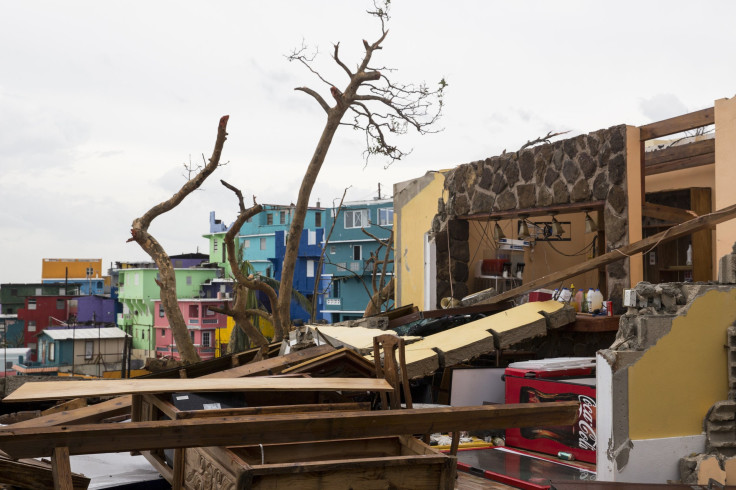Hurricane Maria Blows Away Roofs In Puerto Rico But Not Jesus Photo

Hurricane Maria whipped through Puerto Rico on Wednesday as a Category 4 storm, with wind speeds as high as 155-mph winds and torrential rains that inundated many parts of the island.
The hurricane, considered to be the strongest to hit the island since 1932, left the entire place — with a population of some 3.4 million people — without power, a situation officials and Puerto Rico Gov. Ricardo Rosselló said could last for several months.
Roofs of numerous buildings were blown away, and properties and houses in capital SanJuan were damaged as the hurricane tore through the unincorporated territory of the U.S.
The extent of the damage on the island was still being surveyed as the eye of the storm moved offshore overnight, but the danger still remained Thursday.
Amidst the destruction, a Twitter user posted a photo on her account showing a property whose roof was blown off by the strong winds; however a photo of Jesus stayed intact and nailed to the wall.
Social media users were quick to react to the photo, mocking it and expressing surprise and saying that Jesus was as “tough as nails.”
The roof blew off but Jesus survived #HurricaneMaria #puertorico pic.twitter.com/xjuiV1KrPI
— Angela Magana (@AngelaMagana1) September 22, 2017
— DatsMyUserName (@NahSon729) September 22, 2017
Tough as nails that guy.
— John Graham (@JohnGrahamIV) September 22, 2017
Meanwhile, Rosselló told CNN on Wednesday night that the entire power system in Puerto Rico was down and no one on the island has access to power from utilities. Puerto Rico, a territory which has been through a long recession and has been in severe debt, has a power grid that is "a little bit old, mishandled and weak," Rosselló told CNN.
"It depends on the damage to the infrastructure," he said. "I'm afraid it's probably going to be severe. If it is ... we're looking at months as opposed to weeks or days."
Rosselló also mentioned that officials thought some of the power stations were not that badly affected, however the distribution system had been ruined.
The governor said that chances were likely that the power could get restored sooner if the transmission lines were in a better shape than thought.
San Juan Mayor Carmen Yulín Cruz said the devastation caused by the storm in the capital city was unlike any she had ever seen in years, NBC News reported.
"The San Juan that we knew yesterday is no longer there," Cruz said. "We're looking at 4 to 6 months without electricity."
The National Hurricane Center predicted “life-threatening” flooding in the area from up to 25 inches of rain in the coming days.
Life-threatening flooding expected in Puerto Rico, Virgin Islands, portions of Hispaniola, and the SE Bahamas and Turks & Caicos #Maria pic.twitter.com/p0QGoegTBX
— National Hurricane Center (@NHC_Atlantic) September 20, 2017
President Donald Trump approved a federal disaster declaration for Puerto Rico, the White House said Wednesday. On Tuesday evening the president had called Maria a “monster hurricane” and tweeted to Puerto Ricans to “be careful, our hearts are with you- will be there to help!”
Rosselló said they had information about one person being dead in the storm when a board was ripped from a house it had been nailed to by the strong winds and then hit a man. He said there might be other casualties but they do not know yet as it was hard to communicate, CNN reported.
"We still don't have a lot of information," he said. "We're virtually disconnected in terms of communications with the southeast part of the island."
Gregorio Cortes 39, a doctor in Vistamar Marina, a community in Carolina, Puerto Rico, said several highways were impassible after the storm due to severe flooding. "This morning I wasn’t able to get across several major highways here since there’s flooding everywhere and fallen trees," he said by phone Thursday evening, according to NBC News.
Cell phone communication and phone lines were also damaged to the extent that they had been completely cut off from Thursday morning until around 4 p.m. EDT on that day, he said, as he was unable to reach his parents and grandparents.
"It’s a feeling of impotence that you have you want to do so much and you can do so little," he said.
Cortes added that Puerto Ricans had lived through several previous hurricanes on the island, but had never experienced something like Maria.
"I’ve never been in a war zone, but what you see in movies — it’s like that," he added.
Meanwhile, the death toll from Maria has risen to at least 15 on the small Caribbean island of Dominica, according to Prime Minister Roosevelt Skerrit. Two people were also said to have been killed on the French Caribbean island of Guadeloupe, officials said, according to the New York Times.
© Copyright IBTimes 2024. All rights reserved.












